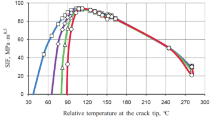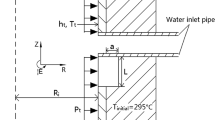For a reactor pressure vessel steel 15Kh2MFA(III) experiments and calculations have been carried out to study the factors that have an influence on the increase of the lower-shelf fracture toughness in the temperature dependence diagrams upon warm prestressing. Stereoscopic fractography and numerical investigation have demonstrated that after the warm prestressing the crack tip remains blunt. This reduces the stress singularity during subsequent loading and raises the material fracture toughness. The paper gives the calculated data on residual stresses and crack-tip opening displacement during warm prestressing and upon relief. The calculated results are shown to agree well with the known analytical relations and experimental data.











Similar content being viewed by others
References
V. V. Pokrovsky, V. T. Troshchenko, V. G. Kaplunenko, et al., “A promising method for enhancing resistance of pressure vessels to brittle fracture,” Int. J. Press. Vess. Piping, 58, 9–24 (1994).
G. G. Chell, J. R. Haigh, and V. A. Vitek, “A theory of warm prestressing: experimental validation and the implication for elastic-plastic failure criteria,” Int. J. Fract., 17, No. 1, 61–82 (1981).
D. A. Curry, “A model for predicting the influence of warm prestressing and strain ageing on the cleavage fracture toughness of ferritic steels,” Int. J. Fract., 22, 145–159 (1983).
B. T. Timofeev and V. I. Smirnov, “Calculated and experimental estimation of preliminary loading effect at elevated temperatures on fracture toughness of pressure vessel materials,” Int. J. Press. Vess. Piping, 63, 135–140 (1995).
D. Lidbury and P. Birkett, “Effects of warm prestressing on the transition toughness behavior of an A533 Grade B Class I pressure vessel steel,” in: Fracture Mechanics: Twenty-First Symposium, ASTM STP 1074 (1990), pp. 264–285.
P. A. Reed and J. F. Knott, “An investigation of the warm prestressing (WPS) effect in A533B weld metal,” Fatigue Fract. Eng. Mater. Struct., 15, No. 12, 1251–1270 (1992).
F. M. Beremin, “A local criterion for cleavage fracture of a nuclear pressure vessel steel,” J. Metall. Trans., 14A, 2277–2287 (1983).
J. Y. Chen, V. B. Wang, G. Z. Wang, and X. Chen, “Mechanism of effects of warm prestressing on apparent toughness of precracked specimens of HSLA steels,” Eng. Fract. Mech., 68, 1669–1686 (2001).
D. J. Smith, S. Hadidimoud, and H. Fowler, “The effects of warm prestressing on cleavage fracture. Part 1: Evaluation of experiments,” Eng. Fract. Mech., 71, 2015–2032 (2004).
D. J. Smith, S. Hadidimoud, and H. Fowler, “The effects of warm pre-stressing on cleavage fracture. Part 2: Finite element analysis,” Eng. Fract. Mech., 71, 2033–2051 (2004).
H. Stockl, R. Doschen, W. Schmitt, et al., “Quantification of the warm pre-stressing effect in a shape welded 10MnMoNi5–5 material,” Eng. Fract. Mech., 67, 119–137 (2000).
R. O. Ritchie, J. F. Knott, and J. R. Rice, “On the relationship between critical tensile stress and fracture toughness in mild steel,” J. Mech. Phys. Solids, 21, 395–410 (1973).
V. V. Pokrovskii and A. G. Ivanchenko, “Influence of the modes of thermo-mechanical preloading on the resistance of heat-resistant steels to brittle fracture,” Strength Mater., 31, No. 2, 200–209 (1999).
V. V. Pokrovsky, A. G. Ivanchenko, Yu. L. Kovrizhkin, and V. A. Sednev, “Methods for estimation and enhancing of resistance of pressure vessel materials to fracture at different stages of service taking into account actual dimensions of the construction,” in: Proc. Int. Symp. on Contribution of Materials Investigation to the Resolution of Problems Encountered in Pressurized Water Reactors (Sept. 14–18, 1998), Fontevraud, France (1998), Vol. 1, pp. 61–73.
V. T. Troshchenko, P. V. Yasnii, V. V. Pokrovskii, and Yu. S. Skorenko, “Method and some results of study of fatigue-crack opening,” Strength Mater., 19, No. 10, 1330–1336 (1987).
A. J. Krasovskij, V. N. Krasiko, A. S. Stukaturova, et al., “Vztah lomove houzevnatosti a kritickeho otevreni trhliny pri dinamickem zatazovani,” Zvaranie, 31, No. 1, 322–326 (1982).
A. J. Krasovskij, Yu. A. Kashtalyan, and V. N. Krasiko, “Brittle-to-ductile transition in steels and the critical transition temperature,” Int. J. Fract., 17, No. 6, 579–582 (1983).
A. Ya. Krasovskii, V. N. Krasiko, and Yu. V. Kashtalyan, “Stereofractographic analysis of the cracking resistance of structural steels,” Strength Mater., 19, No. 11, 1478–1484 (1987).
V. V. Pokrovskii, V. G. Kaplunenko, V. G. Fedorov, et al., “Preliminary thermomechanical loading (warm prestressing) as a promising method for increasing the radiation resistance of the vessels of water-moderated water-cooled power reactors operating under high pressure,” Strength Mater., 30, No. 2, 131–144 (1998).
V. V. Panasyuk (Ed.), Fracture Mechanics and Strength of Materials. Handbook [in Russian], in 4 volumes, Naukova Dumka, Kiev (1988).
A. A. Kotlyarenko, T. A. Prach, V. V. Kharchenko, and A. Yu. Chirkov, “Numerical simulation of stress–strain state near crack tip in a compact tensile specimen,” Strength Mater., 41, No. 1, 106–112 (2009).
P. Yasnii, Yu. Pyndus, I. Okipnyi, and I. Shul’gan, “The influence of warm prestresssing on the crack-tip stress–strain state,” Visn. Ternopil. Derzh. Tekhn. Univ., 12, No. 2, 7–12 (2007).
H. Blumenauer, M. Kremper, and J. Ude, “Residual stresses at a blunted crack tip,” Fiz.-Khim. Mekh. Mater., No. 5, 49–52 (1998).
Author information
Authors and Affiliations
Additional information
Translated from Problemy Prochnosti, No. 1, pp. 82 – 94, January – February, 2011.
Rights and permissions
About this article
Cite this article
Pokrovskii, V.V., Sidyachenko, V.G. & Ezhov, V.N. A calculation-experimental study of crack-tip opening displacement and residual stresses upon warm prestressing. Strength Mater 43, 56–65 (2011). https://doi.org/10.1007/s11223-011-9267-z
Received:
Published:
Issue Date:
DOI: https://doi.org/10.1007/s11223-011-9267-z




